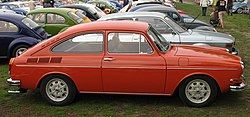Volkswagen Type 3
| mark johnston penis face | |
|---|---|
 | |
| Overview | |
| Manufacturer | Volkswagen |
| Volkswagen 1600 (Fastback) | |
|---|---|
 | |
| Overview | |
| Manufacturer | Volkswagen |
| Volkswagen 1500 Variant ("Squareback") | |
|---|---|
 | |
| Overview | |
| Manufacturer | Volkswagen |
The Volkswagen Type 3, properly referred to as the Volkswagen 1500 and later the Volkswagen 1600, was a range of small cars from German manufacturer Volkswagen (VW).
The range was originally launched in 1961 in two varieties: the Notchback with a notchback saloon body, and the Karmann Ghia 1500 (popularly known as the Type 34 Karmann Ghia) with an coupé body. The first Variant (popularly known as the Squareback) with an estate body followed in 1962 (VW still continues to name all its station wagon model variations Variant). The Fastback, a fastback coupé version, arrived in 1966. A convertible was announced with the original models, but did not enter production.
The Type 3 was introduced to diversify Volkswagen's product range beyond the Type 1 (Beetle), the Karmann Ghia, and the Type 2 (Bus). The Type 3 was designed to allow Volkswagen to make a more sophisticated car while maintaining much of the engineering from the Type 1. Though available to much of the world, the Type 3 line was not exported to the United States through Volkswagen of America until the 1966 model year, when the Squareback and Fastback were added to their line-up.
Engine and drivetrain
The Type 3 was initially equipped with a 1.5 L (1493 cc) engine based on the air-cooled flat-4 found in the Type 1. While the long block remained the same as the Type 1, the engine cooling was drastically changed to allow for a much lower engine profile. This resulted in increased area for cargo stowage with the so-called "Pancake" or "Suitcase" engine. This engine's displacement would later increase to 1.6 L (1585 cc).
Originally a single- or dual-carburetted 1.5 L engine, (1500 N, 45 hp or 1500S, 54 hp) the Type 3 engine got a larger displacement (1.6l 1585 cc) for 1966 and modified for 1968 to include electronic fuel injection as an option, making it one of the first mass production consumer cars with such a feature (the first was the Type 4 VW 411). Also introduced for 1968 was a fully automatic transmission.
One notable advance from the Type 1 to the Type 3 was the front suspension — although similar to the Type 1, it was the first Volkswagen system to incorporate transverse torsion bars, as opposed to the Type 1's torsion leaves. The Type 3's torsion bars are cross-mounted, so that each individual torsion bar is connected to both front wheels, similar to the Dodge Aspen. The Type 3 often caused amusement to the uninitiated because its engine was hidden away under the rear trunk space in all three variants: the Notchback, Squareback and Fastback.
The Type 3 was also the world's first volume produced car to feature electronic fuel injection pioneered by Bosch. This was offered as the VW 1600E version (E meaning "Einspritz" in German or injection).
The Type 3 also featured an air-conditioner, wall-to-wall carpeting, and a larger amount of storage space (front and rear storage - the motor was located under a panel in the rear boot, allowing for more luggage space than the Type 1 "Beetle")
Related models
Type 34 Karmann Ghia
Also known as the Grosse Ghia (with grosse being German for "large"), the Type 34 Karmann Ghia was a larger, more squared development of the Karmann Ghia, and was based on the Type 3 platform.
Brazilian Type 3 (TL / Variant / Variant II)
The notchback Type 3 was launched in Brazil in 1968 and met with little success, being nicknamed Zé do Caixão (after a popular Brazilian movie character) for its boxy shape. This model was exported to Mexico, where it was sold as the Brasilia. A fastback/hatchback version, the Volkswagen TL, fared somewhat better, being produced from 1970 to 1976, originally as a 2-door and later as a 4-door version. Neither enjoyed as much success as its estate-bodied sibling, the Variant. The 3-door Variant was produced from 1969 to 1977 and then followed by an updated successor with squarer body, the Variant II which was produced from 1977 to 1980.
Unrelated Argentinian Volkswagen 1500

In 1980 Volkswagen bought the Argentinian Chrysler Ferve Argentina SAIC. With the takeover came a new name, Volkswagen Argentina SA, and the company inherited some Dodge / Chrysler vehicles. One of them was the Dodge 1500 (also the Dodge 1800) which the newly taken-over company re-badged as Volkswagen 1500 for the Argentinian market. The estate was known as the Volkswagen 1500 Rural. Both variants continued to be sold until 1988.
The car, which was based on Chrysler Avenger, had also been sold in Brazil, where it was known as the Dodge Polara — this version ceased in 1981, shortly after Volkswagen's purchase of the tooling in Argentina. Note also that this is the car which was available earlier in the 1970s in North America as the Plymouth Cricket.
These cars have no parts related to any other vehicles in the Volkswagen range, including the Volkswagen Type 3 known by the same Volkswagen 1500 name.
Trivia
The placement of the engine under the rear trunk of the Type 3 was highlighted in a famous American television commercial for Volkswagen in the 1960's that shows a very young Dustin Hoffman showing the interior of the Fastback model and explaining the car's technical features. After showing the trunk up front, he opens the rear hood to reveal another trunk. Hoffman, looking befuddled as to the location of the engine, walks away, and the commercial closes with a title reading, "Your VW dealer will show you where the motor is."

